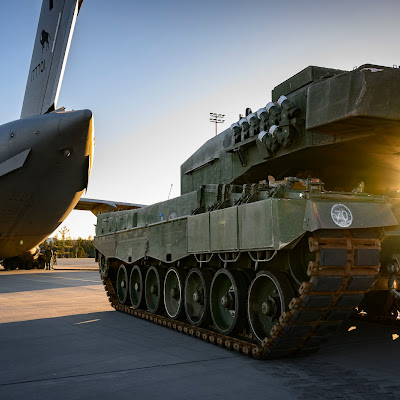By Stijn Mitzer and Joost Oliemans
Cuba is widely known for its former leader Fidel Castro, a surprisingly enduring devotion to communism and its world-renowned cigars, exporting the latter two to numerous countries across the globe. By contrast, its role as an exporter of arms remains much more obscure. While Cuba has begun converting and manufacturing a wide range of arms-related equipment in recent times, this industry has so far mostly been serving the needs of Cuba's own Fuerzas Armadas Revolucionarias (FAR). The presence of Cuban 'David' infantry mobility vehicles (IMVs) in service with the Forças Armadas Angolanas is thus highly notable.
The strong relationship between Cuba and Angola, established during the latter's freedom struggle against Portuguese colonial rule of the country, has had a significant influence on Angola and its armed forces, but was not known to have materialised in the delivery of military equipment to Angola over the past decades. The continuation of this bond between the countries even in the 21st century was once more affirmed by meetings of Angolan and Cuban officials, where ministers stated their willingness to continue and even strengthen cooperation in the military field. [1]
The David IMV, also known as 'Iguana' (for the species of lizard native to Cuba), was first spotted in service with the Angolan Army during the Southern African Development Community's (SADC) multinational exercise 'Vale do Keve 2014', where it carried out simulated missions alongside Namibian Casspir MRAP (Mine-Resistant Ambush Protected) vehicles. The David had first been sighted in Cuba several years earlier, taking part in the 50th Anniversary of Playa Giron's Victory parade in 2011 in commemoration of the failed 1961 Bay of Pigs invasion by U.S. proxy forces.
 |
Two Namibian Casspir MRAPs lead a convoy of David IMVs |
The armament of the vehicle consists of a single 7.62mm PKT vehicle machine gun taken from the turrets of BTR-60 APCs or BRDM-2 patrol cars that had been converted to serve in different roles, having lost their turret in the process. These vehicles are also the source of the roof hatches, up to four of which are present on the David. Two IMV variants are known to exist, one with no such hatches and one with four of them, which is the variant in service with Angola. Three viewing ports with associated firing ports (also taken from BTR-60s) are located on each side of the vehicle.
Another variant serves the role of command vehicle for BM-21 multiple rocket launcher (MRL) battalions, replacing the GAZ-66 and UAZ-469 previously used for this purpose. In turn, several of these UAZ-469s were converted to fast attack vehicles for use with Cuba's special forces, showing that few systems are ever truly retired until they're completely worn out in this country where scarcity is inescapable. [2]
Still more specialised variants exist, including a communications vehicle donning large antennas and a satellite dish on the roof of the vehicle, replacing the hatches and PKT gunner's position. These vehicles are to ensure effective communications between the three different army regions guarding Cuba's vast land mass, the length of which covers the same distance as from Kyiv to Berlin.
Prior to the production of the David IMV, Cuba already had limited
experience in the manufacturing and conversion of several types of
vehicles by replacing weaponry or adding additional armour for increased
protection on the battlefield. At least some of these vehicles were
subsequently used in Angola, where elements of the Cuban Army and Air
Force were fighting in support of the MPLA against UNITA, the FNLA, the
FLEC and the South African Defence Force (SADF) in the 1970s and 1980s.
While the Cuban contingent deployed to Angola mostly served as advisors
or in counter-insurgency operations, they frequently engaged in direct
combat with the SADF as well. Although often credited for defeating the
SADF, causing the latter to pull out of the Angolan conflict and grant
South West Africa independence (becoming Namibia in 1990), the Cubans
suffered a string of defeats at the hands of the SADF. However, their resilience ultimately convinced the SADF that this conflict could not be won
without a significant increase in commitment and resources, thus
essentially gaining the Cubans a strategic victory in Angola through their presence rather than a military one.
 |
A David IMV acting as a command vehicle for the Bandera-VI-M 'Remulgadas' coastal defence system complex. Also note the PKT machine gun. |
In more recent years several types of otherwise redundant vehicles and equipment were taken out of storage for conversion to new roles in an effort to increase the Cuban military's fighting capabilities, sometimes leading to dubious contraptions with little fighting value in case of war, but also leading to more realistic projects such as the David IMV. Other examples of these conversions include the mating of surface-to-air (SAM) launchers onto the chassis of T-55 tanks, and the installation of anti-tank guns, anti-aircraft guns, and artillery on the chassis of BMP-1s, T-55s and even World War II-era T-34/85s.
While the prospect of more Cuban weaponry showing up in countries
throughout the world is not very likely, the sighting of such an exotic
vehicle in Africa once again showcases the complexity and opaqueness of the international
arms market, necessitating accurate analysis to keep track of the way
armament proliferates. This particular vehicle serves as an excellent
illustration of this fact, adding to Angola's armed forces' arsenal of
extremely diverse fighting vehicles, many of which originated from
unconventional sources – even including North Korea.
[1] Cuba and Angola will grow their military cooperation between the two armies https://www.armyrecognition.com/august_2011_news_defense_army_military_industry_uk/cuba_and_angola_will_grow_their_military_cooperation_between_the_two_armies_1009111.html
[2] The Oryx Handbook of Cuban Fighting Vehicles https://www.oryxspioenkop.com/2019/08/cuban-fighting-vehicles.html
Recommended Articles:

.png)










